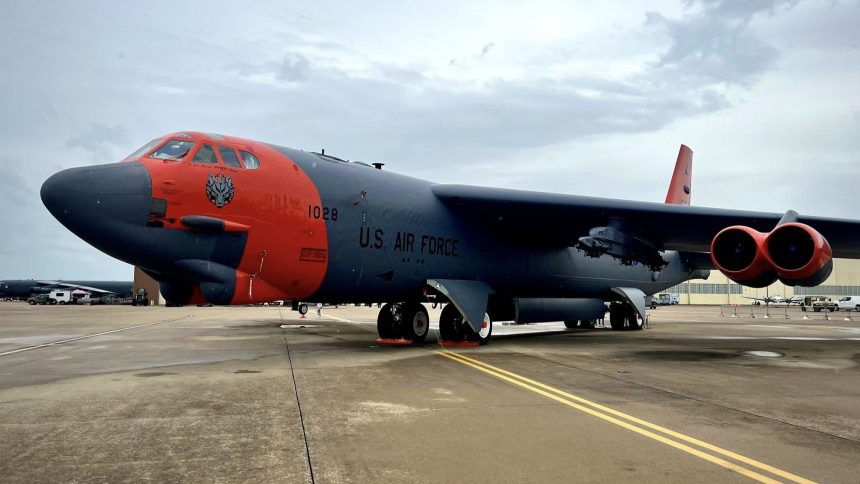The 49th Test and Evaluation Squadron revealed the finished livery of the heritage orange B-52H which pays tribute to the NB-52A and NB-52E.
Few months after it was first spotted with the new throwback color scheme, the B-52H 61-0028 has now received all the missing decals, completing the amazing heritage orange livery. In fact, the official Facebook page of the 53rd Wing, the lead operational test wing for the U.S. Air Force, released the photos of the now completed livery of the Orange BUFF (Big Ugly Fat Fellow) on display during the recent air show at Barksdale Air Force Base, Louisiana, where it is based.
The aircraft was on static display on Mar. 29 and 30, 2025, with the 49th Test and Evaluation Squadron, which is assigned this specific B-52, revealing the newly added decals to the heritage orange livery. These include the classic Operational Test “OT” tail flash, the squadron’s Wolfpack emblem, black arrow point on the tail and colored USAF roundels.
“This throwback design pays tribute to the legendary NB-52E while keeping our heritage alive,” mentioned the Facebook post. In a comment, the unit explained that “the 49th TES took inspiration from multiple aircraft, including the NB-52A, NB-52E, and the iconic X-1,” further adding that “the roundels on the sides and the ‘USAF’ markings on the wings and fuselage pay tribute to the NB-52’s paint scheme, bringing together elements from these legendary planes.”
The heritage orange B-52
The Statofortress’ new retro livery was first spotted while the aircraft was taking off from Tinker Air Force Base, Oklahoma, home of the Oklahoma City Air Logistics Complex, on Sept. 30, 2024. Our friend Rob Stephens at Redhome Aviation, who photographed the B-52, told us that the B-52H 61-0028 arrived at Tinker AFB, mostly without paint and an orange rudder, on Aug. 26, 2024, headed towards a special paint job.
The B-52H 61-0028 “Wolfpack” had forward fuselage, wings near the wingtips, engine nacelles, and vertical stabilizer painted in dayglo orange, contrasting the typical overall dark gray paint of the Stratofortress aircraft. As explained at the time, the bomber was not given any markings, as the “OT” and “49 TES” tail markings, black arrow point on the tail, and “U.S. Air Force” on the fuselage were to be applied upon return to Barksdale AFB.
Specifically, the livery is similar to the famous NB-52B 52-0008 and closely resembles the NB-52A 52-0003, but also drew inspiration from the lesser-known NB-52E 56-0632. When the first official photos were released on Sep. 30, when the aircraft returned to Barksdale, the service said “the test orange scheme was used to remind everyone of the B-52’s incredible journey and continuous progress made in the U.S. Air Force.”
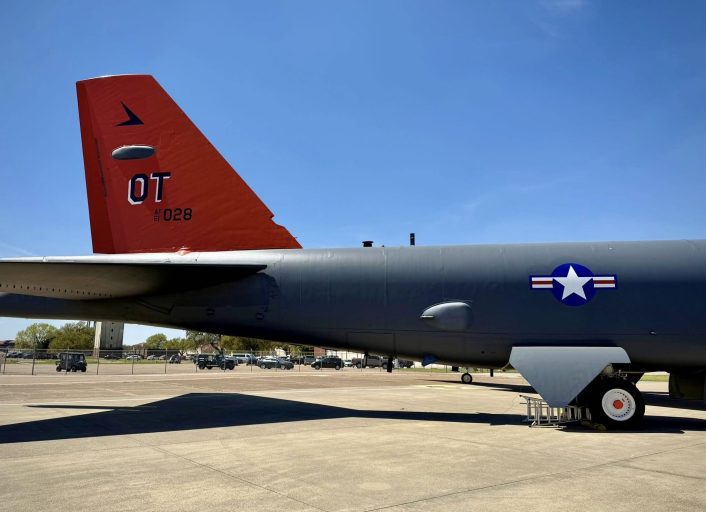
The original orange BUFFs
In mid-1957, NASA made the decision to replace the B-36 Peacemaker with the B-52 Stratofortress as the launch aircraft for the X-15 hypersonic research program. The B-36 was nearing the end of its operational life, and it was anticipated that finding spare parts to maintain it after retirement would be challenging.
As the X-15 project advanced, two B-52 Stratofortresses, the NB-52A and NB-52B, were chosen to serve as the launch platforms. The NB-52B, designated 52-0008 and nicknamed “The Challenger,” continued in this role until its last mission in November 2004, while the NB-52A, known as “The High and Mighty One” with tail number 52-0003, was retired earlier in 1969.
The NB-52A was specifically the third and last B-52A built, modified with liquid oxygen and hydrogen peroxide tanks installed in the bomb bays, and carried the X-15 on 93 of the program’s 199 flights from 1959. Today, “The High and Mighty One” is still preserved and displayed at the Pima Air & Space Museum in Arizona, with its distinctive orange markings.
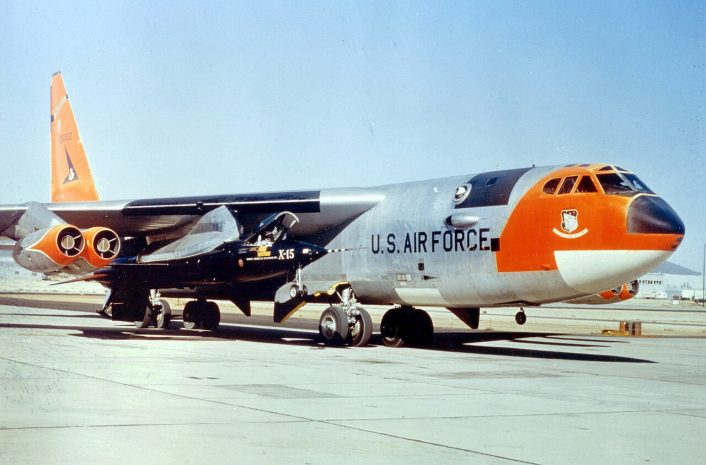
The NB-52B, initially built as RB-52B and used as test aircraft for the navigation systems, served since 1959 as an airborne launch platform, essentially acting as a flying launch pad on 106 X-15 flights. It operated at altitudes of nine miles, providing the rocket planes it carried with necessary fuels, gases, and electrical power.
To handle this role, the right wing of the aircraft was reinforced and equipped with a pylon capable of carrying over 50,000 pounds—approximately a fifth of the aircraft’s total weight. This made the Stratofortress a crucial asset in various aeronautical research endeavors, including those that eventually contributed to the development of the Space Shuttle.
In fact, one of the NB-52B’s key contributions was helping validate the Space Shuttle’s steep gliding landings. It accomplished this by launching wingless lifting bodies, which demonstrated that such landings were possible. This was not the only contribution to the program, as the aircraft also played a vital role in testing parachutes for recovering the Shuttle’s solid rocket boosters and the drag chute used during Shuttle landings.
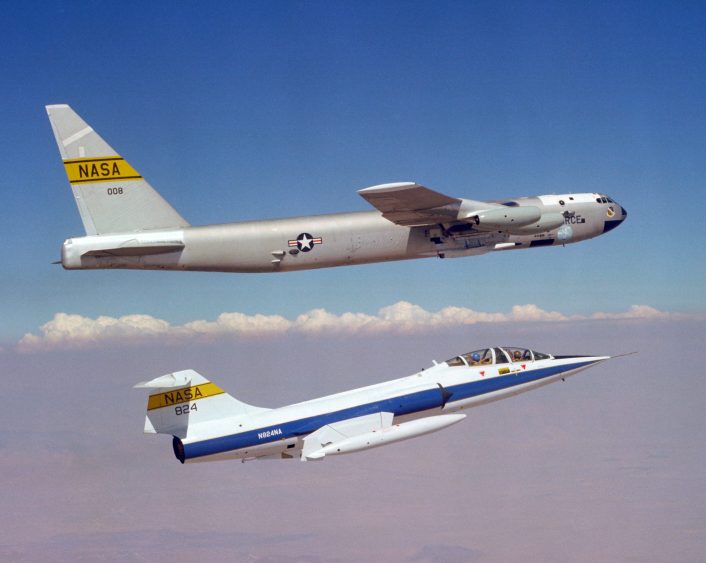
Despite its increasing age and the growing cost of maintenance, the NB-52B continued to support a wide array of cutting-edge research throughout the 1970s and 1980s, launching drones, remotely piloted vehicles, and experimental payloads. In addition to its launch duties, the NB-52B was used in research on wake turbulence, served as a target for gunnery exercises, and tested fuel additives aimed at reducing pollution.
At one point, it flew with ten engines when additional engines were mounted under the bomb bay for testing purposes. During the X-38 program, the aircraft deployed the largest parafoil in history, with a surface area larger than a Boeing 747’s wing.
The NB-52B’s last mission took place in 2004, when it launched the X-43A, which reached a speed of Mach 9.6 using the most powerful air-breathing engine ever built. After a long and significant career contributing to both aviation and space research, the NB-52B was officially retired on Dec. 17, 2004, during a ceremony at NASA’s Dryden Flight Research Center.
At the time of its retirement, “Balls 8” (a nickname derived from its NASA tail number 52-008, where military slang refers to leading zeroes as “Balls”) was the oldest B-52 still in active service and the only one that wasn’t an H model. It also had the lowest total flight hours of any operational B-52. The aircraft is now displayed permanently near the north gate of Edwards Air Force Base in California.
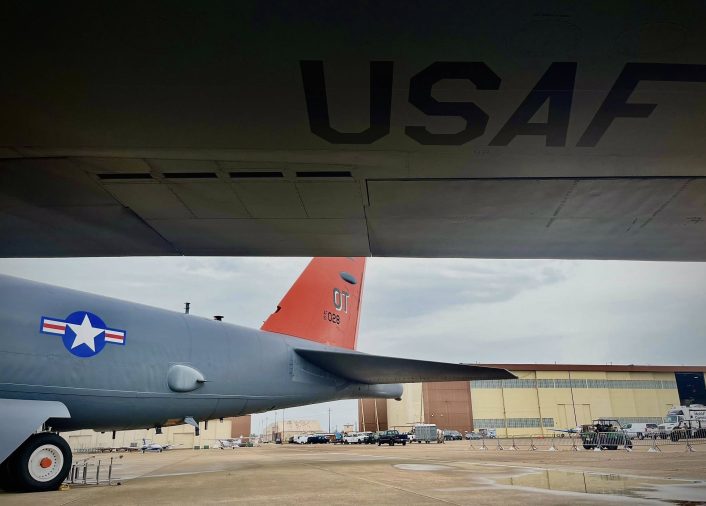
The NB-52E, tail number 56-0632, was the second B-52E produced, heavily modified to carry out specialized developmental projects. Among its crucial contributions were studies on electronic flutter and buffeting suppression systems, key research areas since several B-52s had been lost due to structural failures caused by aerodynamic stresses during low-level flights.
To combat these issues, the NB-52E was fitted with small swept winglets alongside the nose, and a long probe extended from the nose. The wings were also equipped with twice the number of control surfaces, and traditional mechanical and hydraulic linkages were replaced by cutting-edge electronic systems.
Inside the aircraft, a wealth of measuring instrumentation supported its research mission. The NB-52E was later involved in the Load Alleviation and Mode Stabilization (LAMS) project, which aimed to reduce the fatigue damage caused by wind gusts. Sensors installed on the aircraft detected and measured gusts, automatically activating the control surfaces to stabilize the aircraft and mitigate structural stresses. During mid-1973, the NB-52E achieved a significant milestone when it flew 10 knots faster than the speed at which flutter would have typically destroyed the aircraft.

Externally, the B-52E (and also the NB-52E) had a unique feature distinguishing it from the D models: an additional window on the left side of the bombardier/navigation station, which was absent in the D models.
Today, the NB-52E resides in the “Boneyard” at the 309th Aerospace Maintenance and Regeneration Group in Arizona, having served its role in advancing aviation research. The NB-52E, which played an instrumental role in pioneering the fly-by-wire control systems used in modern aviation, represents the innovative spirit that continues to drive the B-52’s modernization.

